Xiao Lu
Towards Source-free Domain Adaptive Semantic Segmentation via Importance-aware and Prototype-contrast Learning
Jun 02, 2023Abstract:Domain adaptive semantic segmentation enables robust pixel-wise understanding in real-world driving scenes. Source-free domain adaptation, as a more practical technique, addresses the concerns of data privacy and storage limitations in typical unsupervised domain adaptation methods. It utilizes a well-trained source model and unlabeled target data to achieve adaptation in the target domain. However, in the absence of source data and target labels, current solutions cannot sufficiently reduce the impact of domain shift and fully leverage the information from the target data. In this paper, we propose an end-to-end source-free domain adaptation semantic segmentation method via Importance-Aware and Prototype-Contrast (IAPC) learning. The proposed IAPC framework effectively extracts domain-invariant knowledge from the well-trained source model and learns domain-specific knowledge from the unlabeled target domain. Specifically, considering the problem of domain shift in the prediction of the target domain by the source model, we put forward an importance-aware mechanism for the biased target prediction probability distribution to extract domain-invariant knowledge from the source model. We further introduce a prototype-contrast strategy, which includes a prototype-symmetric cross-entropy loss and a prototype-enhanced cross-entropy loss, to learn target intra-domain knowledge without relying on labels. A comprehensive variety of experiments on two domain adaptive semantic segmentation benchmarks demonstrates that the proposed end-to-end IAPC solution outperforms existing state-of-the-art methods. Code will be made publicly available at https://github.com/yihong-97/Source-free_IAPC.
Achieving Covert Communication in Large-Scale SWIPT-Enabled D2D Networks
Feb 16, 2023Abstract:We aim to secure a large-scale device-to-device (D2D) network against adversaries. The D2D network underlays a downlink cellular network to reuse the cellular spectrum and is enabled for simultaneous wireless information and power transfer (SWIPT). In the D2D network, the transmitters communicate with the receivers, and the receivers extract information and energy from their received radio-frequency (RF) signals. In the meantime, the adversaries aim to detect the D2D transmission. The D2D network applies power control and leverages the cellular signal to achieve covert communication (i.e., hide the presence of transmissions) so as to defend against the adversaries. We model the interaction between the D2D network and adversaries by using a two-stage Stackelberg game. Therein, the adversaries are the followers minimizing their detection errors at the lower stage and the D2D network is the leader maximizing its network utility constrained by the communication covertness and power outage at the upper stage. Both power splitting (PS)-based and time switch (TS)-based SWIPT schemes are explored. We characterize the spatial configuration of the large-scale D2D network, adversaries, and cellular network by stochastic geometry. We analyze the adversary's detection error minimization problem and adopt the Rosenbrock method to solve it, where the obtained solution is the best response from the lower stage. Taking into account the best response from the lower stage, we develop a bi-level algorithm to solve the D2D network's constrained network utility maximization problem and obtain the Stackelberg equilibrium. We present numerical results to reveal interesting insights.
Semantic Encoder Guided Generative Adversarial Face Ultra-Resolution Network
Nov 18, 2022



Abstract:Face super-resolution is a domain-specific image super-resolution, which aims to generate High-Resolution (HR) face images from their Low-Resolution (LR) counterparts. In this paper, we propose a novel face super-resolution method, namely Semantic Encoder guided Generative Adversarial Face Ultra-Resolution Network (SEGA-FURN) to ultra-resolve an unaligned tiny LR face image to its HR counterpart with multiple ultra-upscaling factors (e.g., 4x and 8x). The proposed network is composed of a novel semantic encoder that has the ability to capture the embedded semantics to guide adversarial learning and a novel generator that uses a hierarchical architecture named Residual in Internal Dense Block (RIDB). Moreover, we propose a joint discriminator which discriminates both image data and embedded semantics. The joint discriminator learns the joint probability distribution of the image space and latent space. We also use a Relativistic average Least Squares loss (RaLS) as the adversarial loss to alleviate the gradient vanishing problem and enhance the stability of the training procedure. Extensive experiments on large face datasets have proved that the proposed method can achieve superior super-resolution results and significantly outperform other state-of-the-art methods in both qualitative and quantitative comparisons.
Securing Large-Scale D2D Networks Using Covert Communication and Friendly Jamming
Sep 30, 2022



Abstract:We exploit both covert communication and friendly jamming to propose a friendly jamming-assisted covert communication and use it to doubly secure a large-scale device-to-device (D2D) network against eavesdroppers (i.e., wardens). The D2D transmitters defend against the wardens by: 1) hiding their transmissions with enhanced covert communication, and 2) leveraging friendly jamming to ensure information secrecy even if the D2D transmissions are detected. We model the combat between the wardens and the D2D network (the transmitters and the friendly jammers) as a two-stage Stackelberg game. Therein, the wardens are the followers at the lower stage aiming to minimize their detection errors, and the D2D network is the leader at the upper stage aiming to maximize its utility (in terms of link reliability and communication security) subject to the constraint on communication covertness. We apply stochastic geometry to model the network spatial configuration so as to conduct a system-level study. We develop a bi-level optimization algorithm to search for the equilibrium of the proposed Stackelberg game based on the successive convex approximation (SCA) method and Rosenbrock method. Numerical results reveal interesting insights. We observe that without the assistance from the jammers, it is difficult to achieve covert communication on D2D transmission. Moreover, we illustrate the advantages of the proposed friendly jamming-assisted covert communication by comparing it with the information-theoretical secrecy approach in terms of the secure communication probability and network utility.
Video Shadow Detection via Spatio-Temporal Interpolation Consistency Training
Jun 17, 2022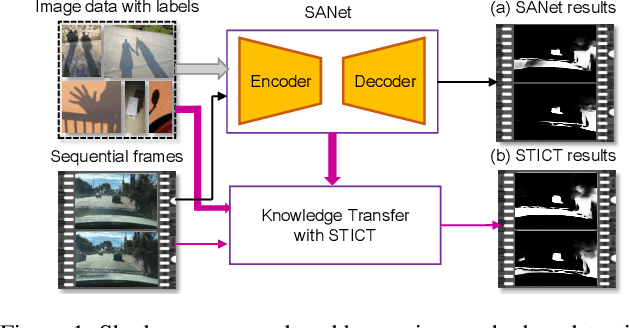

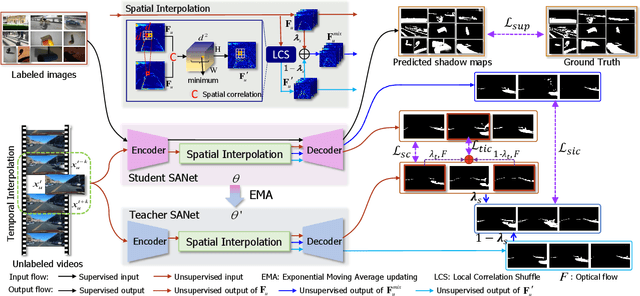
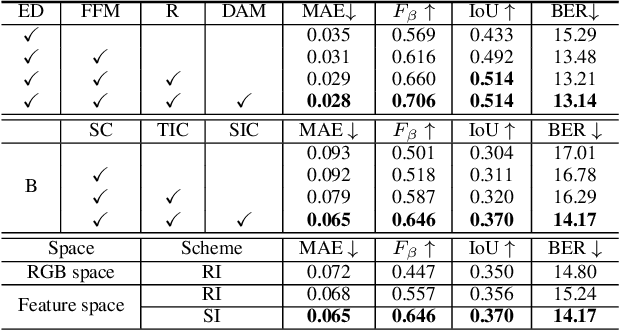
Abstract:It is challenging to annotate large-scale datasets for supervised video shadow detection methods. Using a model trained on labeled images to the video frames directly may lead to high generalization error and temporal inconsistent results. In this paper, we address these challenges by proposing a Spatio-Temporal Interpolation Consistency Training (STICT) framework to rationally feed the unlabeled video frames together with the labeled images into an image shadow detection network training. Specifically, we propose the Spatial and Temporal ICT, in which we define two new interpolation schemes, \textit{i.e.}, the spatial interpolation and the temporal interpolation. We then derive the spatial and temporal interpolation consistency constraints accordingly for enhancing generalization in the pixel-wise classification task and for encouraging temporal consistent predictions, respectively. In addition, we design a Scale-Aware Network for multi-scale shadow knowledge learning in images, and propose a scale-consistency constraint to minimize the discrepancy among the predictions at different scales. Our proposed approach is extensively validated on the ViSha dataset and a self-annotated dataset. Experimental results show that, even without video labels, our approach is better than most state of the art supervised, semi-supervised or unsupervised image/video shadow detection methods and other methods in related tasks. Code and dataset are available at \url{https://github.com/yihong-97/STICT}.
Pseudo-supervised Deep Subspace Clustering
Apr 08, 2021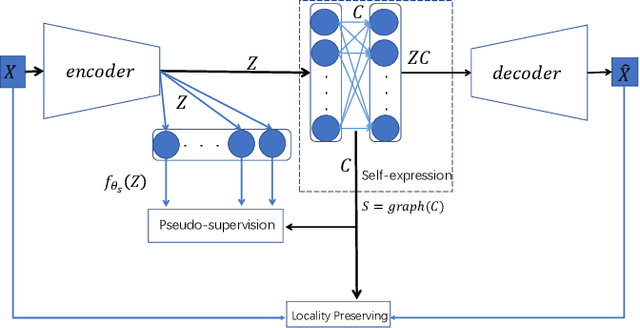
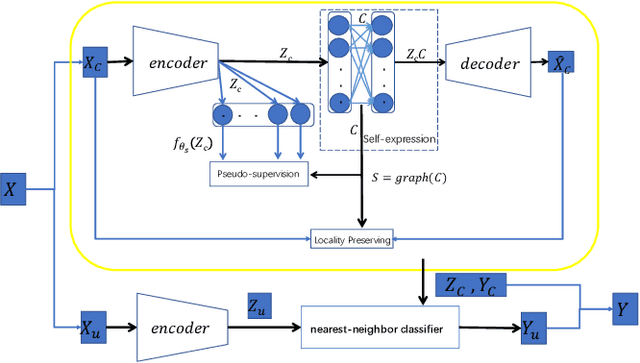
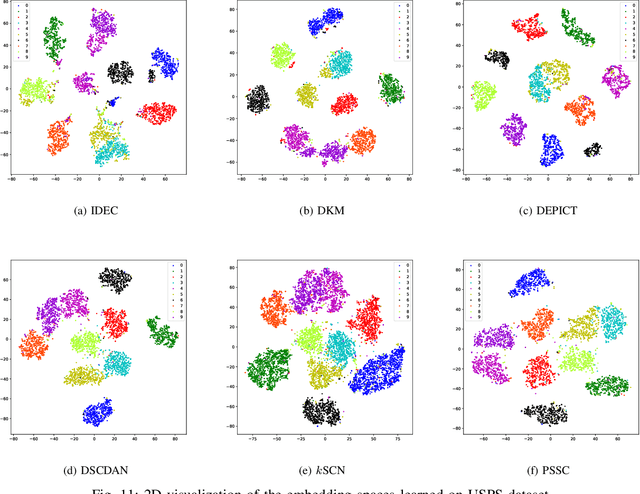
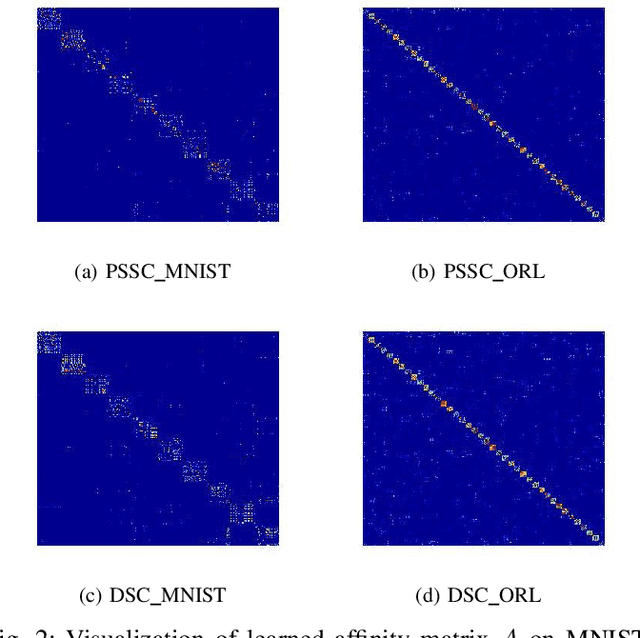
Abstract:Auto-Encoder (AE)-based deep subspace clustering (DSC) methods have achieved impressive performance due to the powerful representation extracted using deep neural networks while prioritizing categorical separability. However, self-reconstruction loss of an AE ignores rich useful relation information and might lead to indiscriminative representation, which inevitably degrades the clustering performance. It is also challenging to learn high-level similarity without feeding semantic labels. Another unsolved problem facing DSC is the huge memory cost due to $n\times n$ similarity matrix, which is incurred by the self-expression layer between an encoder and decoder. To tackle these problems, we use pairwise similarity to weigh the reconstruction loss to capture local structure information, while a similarity is learned by the self-expression layer. Pseudo-graphs and pseudo-labels, which allow benefiting from uncertain knowledge acquired during network training, are further employed to supervise similarity learning. Joint learning and iterative training facilitate to obtain an overall optimal solution. Extensive experiments on benchmark datasets demonstrate the superiority of our approach. By combining with the $k$-nearest neighbors algorithm, we further show that our method can address the large-scale and out-of-sample problems.
Relation-Guided Representation Learning
Jul 11, 2020



Abstract:Deep auto-encoders (DAEs) have achieved great success in learning data representations via the powerful representability of neural networks. But most DAEs only focus on the most dominant structures which are able to reconstruct the data from a latent space and neglect rich latent structural information. In this work, we propose a new representation learning method that explicitly models and leverages sample relations, which in turn is used as supervision to guide the representation learning. Different from previous work, our framework well preserves the relations between samples. Since the prediction of pairwise relations themselves is a fundamental problem, our model adaptively learns them from data. This provides much flexibility to encode real data manifold. The important role of relation and representation learning is evaluated on the clustering task. Extensive experiments on benchmark data sets demonstrate the superiority of our approach. By seeking to embed samples into subspace, we further show that our method can address the large-scale and out-of-sample problem.
Detecting Cyberattacks in Industrial Control Systems Using Online Learning Algorithms
Dec 08, 2019



Abstract:Industrial control systems are critical to the operation of industrial facilities, especially for critical infrastructures, such as refineries, power grids, and transportation systems. Similar to other information systems, a significant threat to industrial control systems is the attack from cyberspace---the offensive maneuvers launched by "anonymous" in the digital world that target computer-based assets with the goal of compromising a system's functions or probing for information. Owing to the importance of industrial control systems, and the possibly devastating consequences of being attacked, significant endeavors have been attempted to secure industrial control systems from cyberattacks. Among them are intrusion detection systems that serve as the first line of defense by monitoring and reporting potentially malicious activities. Classical machine-learning-based intrusion detection methods usually generate prediction models by learning modest-sized training samples all at once. Such approach is not always applicable to industrial control systems, as industrial control systems must process continuous control commands with limited computational resources in a nonstop way. To satisfy such requirements, we propose using online learning to learn prediction models from the controlling data stream. We introduce several state-of-the-art online learning algorithms categorically, and illustrate their efficacies on two typically used testbeds---power system and gas pipeline. Further, we explore a new cost-sensitive online learning algorithm to solve the class-imbalance problem that is pervasive in industrial intrusion detection systems. Our experimental results indicate that the proposed algorithm can achieve an overall improvement in the detection rate of cyberattacks in industrial control systems.
Structure Learning with Similarity Preserving
Dec 03, 2019



Abstract:Leveraging on the underlying low-dimensional structure of data, low-rank and sparse modeling approaches have achieved great success in a wide range of applications. However, in many applications the data can display structures beyond simply being low-rank or sparse. Fully extracting and exploiting hidden structure information in the data is always desirable and favorable. To reveal more underlying effective manifold structure, in this paper, we explicitly model the data relation. Specifically, we propose a structure learning framework that retains the pairwise similarities between the data points. Rather than just trying to reconstruct the original data based on self-expression, we also manage to reconstruct the kernel matrix, which functions as similarity preserving. Consequently, this technique is particularly suitable for the class of learning problems that are sensitive to sample similarity, e.g., clustering and semisupervised classification. To take advantage of representation power of deep neural network, a deep auto-encoder architecture is further designed to implement our model. Extensive experiments on benchmark data sets demonstrate that our proposed framework can consistently and significantly improve performance on both evaluation tasks. We conclude that the quality of structure learning can be enhanced if similarity information is incorporated.
Probabilistic Load Forecasting via Point Forecast Feature Integration
Mar 26, 2019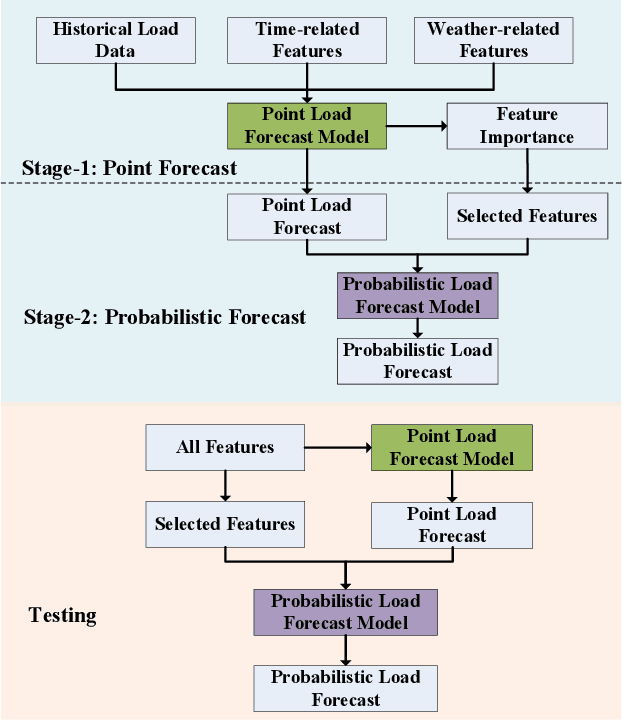
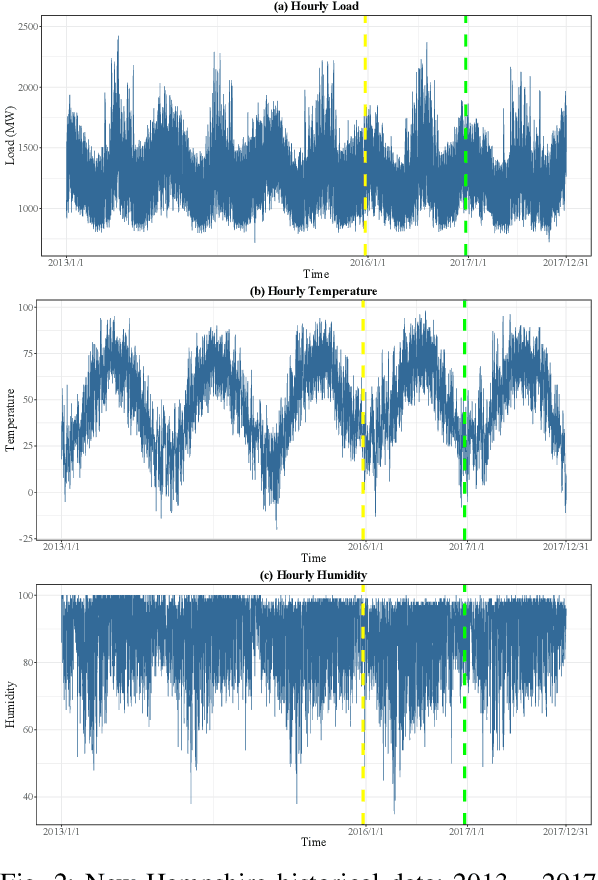
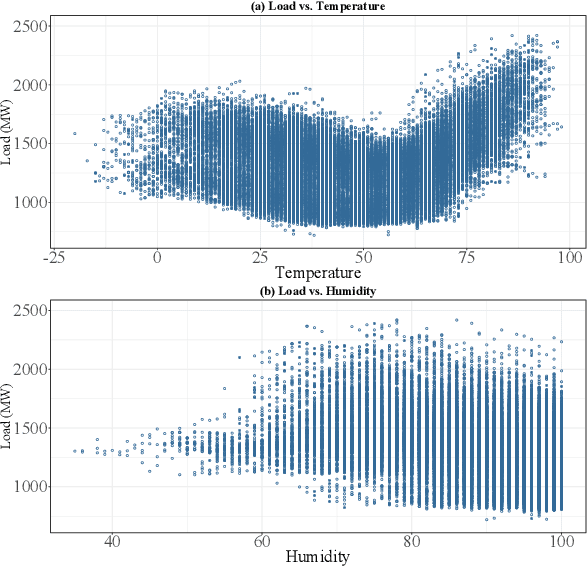
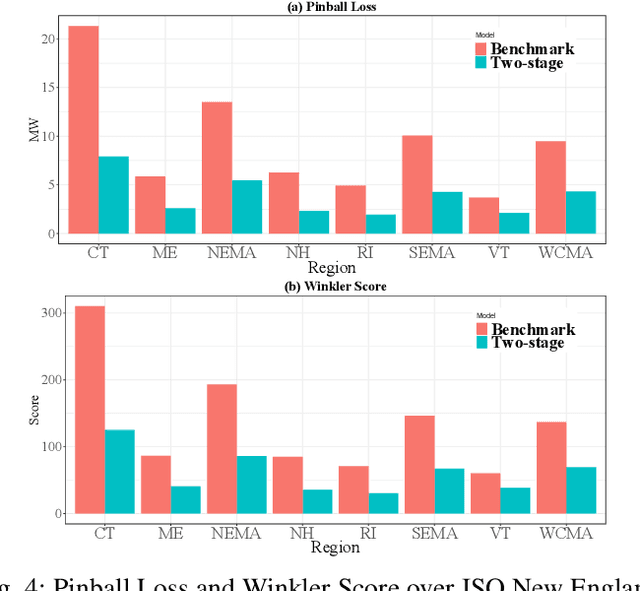
Abstract:Short-term load forecasting is a critical element of power systems energy management systems. In recent years, probabilistic load forecasting (PLF) has gained increased attention for its ability to provide uncertainty information that helps to improve the reliability and economics of system operation performances. This paper proposes a two-stage probabilistic load forecasting framework by integrating point forecast as a key probabilistic forecasting feature into PLF. In the first stage, all related features are utilized to train a point forecast model and also obtain the feature importance. In the second stage the forecasting model is trained, taking into consideration point forecast features, as well as selected feature subsets. During the testing period of the forecast model, the final probabilistic load forecast results are leveraged to obtain both point forecasting and probabilistic forecasting. Numerical results obtained from ISO New England demand data demonstrate the effectiveness of the proposed approach in the hour-ahead load forecasting, which uses the gradient boosting regression for the point forecasting and quantile regression neural networks for the probabilistic forecasting.
 Add to Chrome
Add to Chrome Add to Firefox
Add to Firefox Add to Edge
Add to Edge